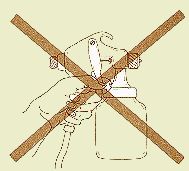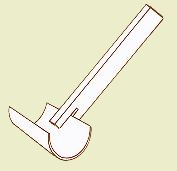

APPLICATIONS: Coating & Encapsulating with POXY-SHIELD®
To obtain all the benefits of the GLEN-L Epoxy Encapsulation System, All wood surfaces must receive at least 2 coats total of POXY-SHIELD®. This assumes that either POXY-SHIELD® or POXY-GRIP® has been used at all joints and bonds also. An additional coat must be applied over any surface which will be sanded (to make up for resin removed by sanding), such as on the exterior of the hull. Furthermore, where the boat will be exposed to the elements at all times (including those boats which remain uncovered in the water throughout the season) a fourth coat is advised on the exterior, including below the waterline. A fifth coat can also be applied if desired for added durability. Additional coats after this will provide few additional benefits. In lieu of the preceding, all exterior surfaces sheathed with fiberglass or comparable materials, using POXY-SHIELD®, need not have any additional epoxy coatings (see heading, Sheathing With POXY-SHIELD®).
For coating applications, the straight product without fillers is usually used. Fillers or pigments should not be added to the first coat as these tend to impair saturation. Do not thin the resin to increase penetration as this will adversely affect its moisture vapor resistance; the wood will absorb resin, even if it's not obvious that it is doing so. Also, do NOT attempt to spray the resins. This would require thinners or solvents which would affect the physical properties and curing characteristics. More importantly there are health hazards connected with spraying epoxies (see heading: Safety). For clear, naturally finished surfaces, do not use fillers.
Whenever possible, all final fairing and shaping of wood members should be done before surface coating applications. lf such work is done after coating, the surfaces will be harder and more difficult to work. lf you know that fairing or shaping will be required later in a certain area, do not coat this area now. Nicks, gouges, indentations, and imperfections can be filled in after the first coating. Wood surfaces should be dry before coating as proper penetration cannot occur on moist wood, and it is not desirable to seal moisture in. Do NOT allow dew, fog, rain, or moisture to settle on any freshly applied coatings. Wood can be stained prior to coating using alcohol-based stains only. Oil based stains, sealer-type stains, or water-base stains should not be used.
POXY-SHIELD®-Fast should be used for all coating applications up to about 75oF or lower, while POXY-SHIELD®-Slow can be used in warmer temperatures above 70oF or where a longer working time is desired. However, when the Fast hardener is used exclusively (whenever working conditions allow), any required sanding can usually be done easily the next day. With the Slow hardener, it may take a full day or two, depending or the temperature.
Mix only as much resin and hardener as can be used in 10 to 15 minutes in order to maintain good penetration and proper viscosity. Coatings are most easily applied with foam rollers; brushes tend to apply uneven coats that sag and require more sanding. Generally, brushes are more costly, however, the inexpensive foam-type brush works as well with the resin as the bristle type. Many builders make their own "brushes" using foam rollers. These rollers are cut lengthwise, then cut into halves or thirds and inserted into a slotted handle (see drawing this section). This is easily accomplished with a saw, but you must decide whether the savings is worth the trouble.
Apply a uniform coating of activated resin with the roller, taking long strokes, but don't try to cover too large an area at one time. The main thing is that the coating should be even, thin coats. This first coat is primarily a base or seal coat and will leave a slightly stippled surface. This is of no consequence since it can be lightly sanded later. You can smooth out the surface with a brush if desired, but this is usually done in subsequent coats.
Some woods are more porous than others and will require additional coating. Recoating is required if surfaces appear dry as the wood soaks up the resin, especially over end and edge grain areas. Inspect the surface after about 15 minutes and recoat any dry areas that appear. In many cases during the first coat, air escaping from the wood will cause small bubbles to appear. This is a proper occurrence and indicates that voids in the wood are being filled with the resin. Ideally, the resin should be thin enough for this to occur and is one reason for the relatively thin viscosity of POXY-SHIELD® resin.
lf you are working at lower temperatures it is important that the resin and hardener be brought up to room temperature, since these materials get thicker when it is cold making rolling and penetration difficult. When this occurs, air release can be prevented or hindered.
Any surface indentations, nicks, and gouges can be filled at any time after the initial coating becomes tack-free (usually 1 to 3 hours with the Fast hardener @ 70oF). An easy-to-sand filler can be made using Microspheres, with a little Silica added for a smoother, easier-to-apply consistency. Lightly sand filled areas level with the surface prior to the next coat or sheathing, which can be applied after the initial coating of resin (see heading, Sheathing With POXY-SHIELD®). A light hand sanding using a sanding block should be all that is necessary at this point; power tools used now may remove too much material. ALWAYS wear a dust mask when sanding, especially when working on coated surfaces that have cured less than a week.
A second coat of activated resin can be applied immediately after the first coat is tack free. There is no absolute necessity for surface preparation (other than sanding filled areas as stated above) if the second coat is applied within two days. However, the second coat of resin technically should be applied as soon as possible to prevent any possible contamination problems. Usually anywhere from an hour up to several hours after the previous coat (depending on temperature). Applying up to 3 coats in a day is possible in warmer climates using Fast hardener, however, sanding between these coats cannot be done.
lf a longer time transpires (more than 48 hours), a light overall sanding together with a solvent wipe is advisable (a solvent wipe is recommended between all coats if allowed to cure (see heading, Clean-up, Solvents, & Thinners). In addition, the resin of the initial coat may tend to make the wood grain fuzzy, making a light sanding necessary prior to the second coat. When this is the case, sanding will be easier if the initial coat is allowed to cure overnight. Wipe the cured surface prior to sanding with a water and ammonia dampened rag or sponge to remove any surface blush (a water soluble waxy-like layer that sometimes appears but is of no consequence) to make such sanding easier. Whether the surface is sanded or not, make sure it is free of moisture before recoating (this treatment applies to all subsequent coats).
For appearance and easier finish work, it is important to make the second coat smooth and even. Use long strokes of the roller in all directions, avoiding build-ups, runs, and sags, working the coat as long as possible, but not to the point where it starts to get tacky (this will leave marks). A single heavy coat is not as desirable as a couple of thinner coats; it is easier to prevent running and sagging, especially on vertical or inclined surfaces, with thin coats.
Cleaning the surfaces of any dust between coats is especially important where natural wood finishes are going to show. A good solvent wipe between coats will assure any contaminants and dust are removed. Remember, All wood surfaces must receive at least 2 coats total of POXY-SHIELD® (three if sanded between coats) as noted before.